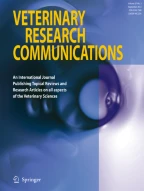Abstract
Dogs and humans have been sharing a common environment for a long time. Some aspects of their social interaction are described as communication in which members of both species influence each other’s behaviour by special behaviour signals. Recent research is aimed at providing an evolutionary account for the emergence of communicative interactions between dogs and people. The present review summarizes how carefully applied experimental methods can be utilised to answer such research questions, in order to separate different processes that may underlie the mental abilities in dogs.
References
Gácsi M., Miklósi A., Varga O., Topál J., Csányi V., 2004. Are readers of our face readers of our minds? Dogs (Canis familiaris) show situation-dependent recognition of human’s attention. Animal Cognition, 7, 144–153.
Gácsi M., Győri B., Virányi Zs., Kubinyi E., Belényi B., Miklósi Á., 2009a. Selection for developmental shift explains dog-wolf difference in comprehension of human gestural signals (submitted).
Gácsi M., McGreevy P., Kara E., Miklósi Á., 2009b. Genetic and Behavioural Effects of selection for Cooperation and Attention in Dogs. (submitted).
Hare B., Brown M., Williamson C., Tomasello M., 2002. The Domestication of Social Cognition in Dogs. Science, 298, 1634–1636.
Hare B. and Tomasello M., 2005. Human-like social skills in dogs? Trends in Cognitive Sciences, 9, 405–454.
Hauser M. D., 1996. The evolution of communication. MIT Press: Cambridge.
Kaminski J., Call J., Fischer J., 2004. Word Learning in a Domestic Dog: Evidence for “Fast Mapping”. Science, 304, 1682–1683.
Krebs R.J. and Davis N.B., 1993. Introduction in behavioural ecology. Oxford University Press: Oxford.
Lakatos G., Soproni K., Dóka A., Miklósi Á., 2009. A comparative approach to dogs’ (Canis familiaris) and human infants’ comprehension of various forms of pointing gestures. Animal Cognition (in press).
Miklósi Á., Polgárdi R., Topál J., Csányi V., 1998. Use of experimenter-given cues in dogs. Animal Cognition, 1, 113–121.
Miklósi Á., Polgárdi R., Topál J., Csányi V., 2000. Intentional behaviour in dog-human communication: An experimental analysis of ‘showing’ behaviour in the dog. Animal Cognition, 3, 159–166.
Miklósi Á., Kubinyi E., Topál J., Gácsi M., Virányi Zs., Csányi V., 2003. A simple reason for a big difference: wolves do not look back at humans but dogs do. Current Biology, 13, 763–766.
Miklósi Á. and Soproni K., 2006. A comparative analysis of the animals’ understanding of the human pointing gesture. Animal Cognition, 9, 81–94.
Miklósi Á., 2007. Dog behaviour, evolution and cognition. Oxford University Press: Oxford.
Morey D.F., 2006. Burying key evidence: the social bond between dogs and people. Journal of Archaeological Science, 33, 158–175.
Pongrácz P., Molnár Cs., Miklósi Á., 2009. Barking in family dogs: An ethological approach. The Veterinary Journal (in press).
Price E.O., 1984. Behavioral aspects of animal domestication. The Quarterly review of Biology, 59, 2–32.
Schwab C. and Huber L., 2006. Obey or not obey? Dogs (Canis familiaris) behave differently in response to to attentional states of their owners. Journal of Comparative Psychology, 118, 103–112.
Soproni K., Miklósi Á., Topál J., Csányi V. 2001. Comprehension of human communicative signs in pet dogs. Journal of Comparative Psychology, 115, 122–126.
Tinbergen N., 1963. On aims and methods of ethology. Zeitschrift für Tierpsychologie, 20, 410–433.
Tomasello T. and Call J., 1997. Primate cognition. Oxford University Press: New York.
Topál J., Gácsi M., Miklósi Á., Virányi Zs., Kubinyi E., Csányi V., 2005. The effect of domestication and socialization on attachment to human: a comparative study on hand reared wolves and differently socialized dog puppies. Animal Behaviour, 70, 1367–1375.
Topál J., Miklósi Á., Gácsi M., Dóka A., Pongrácz P., Kubinyi E., Virányi Zs., Csányi V., 2009. The dog as a model for understanding human social behaviour. Advances in the Study of Animal Behaviour, (in press).
Udell M.A.R., Dorey N.R., Wynne C.D.L., 2008. Wolves outperform dogs in following human social cues. Animal Behaviour, 76, 1767–1773.
Virányi Zs., Topál J. Gácsi M., Miklósi Á., Csányi V., 2004. Dogs can recognize the focus of attention in humans. Behavioural Processes, 66, 161–172.
Acknowledgement
The research of the author is supported by the Hungarian Science Fund (OTKA T049692) and the European Community (FP7 ICT 2007 LIREC 215554).
Author information
Authors and Affiliations
Corresponding author
Rights and permissions
About this article
Cite this article
Miklósi, Á. Evolutionary approach to communication between humans and dogs. Vet Res Commun 33 (Suppl 1), 53–59 (2009). https://doi.org/10.1007/s11259-009-9248-x
Published:
Issue Date:
DOI: https://doi.org/10.1007/s11259-009-9248-x
